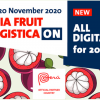Week 33 of 2015 saw many headlines appear within China, with an explosion affecting the port city of Tianjin only a few days after the Chinese Renminbi depreciated against the U.S Dollar by roughly -2.5%. This depreciation of the Renminbi will likely have a notable effect on importers. Imports of winter fruit continue to dominate the market with citrus the main item as far fewer summer fruits were available with the exception of U.S.A cherries. The weather in week 33 as predicted saw rainfall affecting both south and east China on the start of the week with sporadic thunder showers in Guangzhou. Week 34’s forecast is for a mixture of cloudy, partly cloudy and thunder showers in both Guangzhou and Shanghai. Temperatures remain warm however comparatively cooler than in previous weeks.
The market for southern hemisphere citrus remained quite stable in week 33 with no major price changes seen for most of the week in either the Shanghai or Guangzhou. Buyers and sellers in the market however have kept vigilant of supply entering the market in order to make the correct decisions. More orange supply is expected in week 34 as South African valencia enters the market with more significant volumes. South African citrus dominated the market with only Australia also showing notable volumes, countries such as Peru had produce available however to a limited extent. Australian oranges again showed an increase of arrivals during week 33 but remained manageable as the increase was gradual compared to the huge leap of arrivals in week 30/31.
Prices declined slightly further particularly for fruit showing more quality or condition issues. Navels showing more marking, rough skins and softness priced in the range ¥220-230 (count #64/72, 18kg) as higher quality fruit showing good orange colouration coupled with limited blemishes priced and could find sales at between ¥250-260 (count #64/72, 18kg). The firmness of oranges remains of significant importance to those in the market particularly in the current warm weather. Both South African and Australian Cara Cara were available on the market, however the supply of the variety remained limited. Australian produce received a premium compared to South Africa with firmness one of the primary reason being cited. Most Australian Cara Cara could find sales at between ¥180-205 (count #40/45, 10kg) with the best quality fruit pricing higher by ¥10-15. Most South African Cara Cara received sales at between ¥180-200 for a 15kg pack.
South African oranges remained dominated by navel varieties in week 33 before a flood of valencia enters the market in the coming two weeks. Most of the better quality navels from South Africa were price and able to find slow sales at between ¥150-160 (count #48/56, 15kg) as fruit showing rougher surfaces and higher levels of marking priced between ¥125-140. Late navels were able to get better returns than the normal navels with poorer quality fruit with more marking or rougher surfaces pricing between ¥140-160 (count #48/56) as the better quality fruit priced ¥15-20 higher. Cambria and Autumn Gold showing reasonable to good quality priced higher from ¥180 to as high as ¥220, as these varieties have a strong reputation for high sugars and good eating quality. Through most of week 33 good quality valencia from South Africa with firmness to touch, good colouration and limited marking could reach prices of ¥180, however most of the sales were at ¥5-10 less. Valencia showing more marking or lower colouration found movement at a lower price of between ¥150-160 (count #48/56, 15kg). Midknight arrivals with fruit showing higher percentages of yellow coloured surfaces pricing and moving at between ¥170-180 (count #48/56). This as better quality fruit priced ¥10-20 higher. By the end of week 33 however increased volumes put pressure on prices with some fruit showing inconsistent yellow colour as well as higher percentages of marking pricing between ¥140-150.
Grapefruit prices remained favorable in week 33 with Guangzhou’s prices increasing sharply compared to Shanghai. Star Ruby in Shanghai increased gradually with good quality fruit able to find sales at between ¥150-165 (count #40, 17kg), as Guangzhou saw sharp rises during the week with fruit at it’s high point able to move at between ¥175-190 (count #40), with some fruit priced at above ¥200.
Little changed in the lemon market in week 33. Most South African lemons were in the price range ¥230-270 (count #100/113, 15kg). An arrival of Australia lemons showing good quality with firmness and ideal shape opened in week 32 and remained available on the market in week 33 with an asking price of ¥300-320 (18kg).
The price level for Australian Murcott was similar to week 32, with no real change in asking prices. Large arrival expected in week 34 however could reduce market prices. Premium class one fruit remained highly desired at high prices of between ¥460-480 (count #90, 18kg) as second class fruit or arrivals with more blemishes and rougher surfaces priced between ¥310-360 (count #80/90).
To the side South African Valencia exports to China and Hong Kong. Year on year volumes are now down - 34%, while still up by 27% compared to the 2013 season. To the side South African navel exports to China and Hong Kong updated till week 31. To date exports are at 1,4m cartons which represents a decrease of -16% compared to 2014 or increase of 48% compared to 2013. To the side South African grapefruit departures to Hong Kong and China, till week 31 were at 1,41 million cartons which equates to a 30% increase year on year or an increase of over 74% compared to 2013. The updated lemon exports from South Africa, year to date volumes remain up at 1,17 million cartons being sent till week 31 which represents a decrease of -38% compared to 2014 however it is still an increase of 156% compared to 2013.


































添加新评论